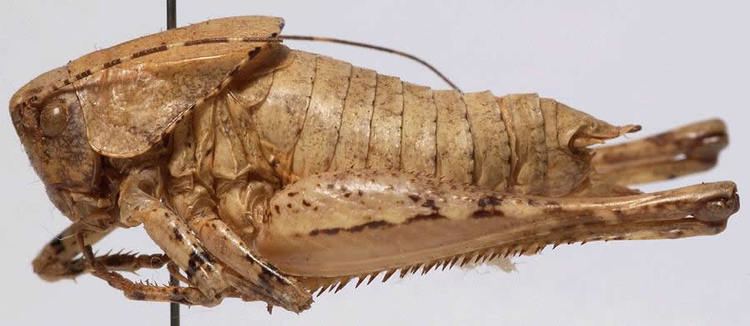Higher classification Neduba | Scientific name Neduba extincta Rank Species | |
 | ||
Similar Insect, Bush crickets, Alloperla roberti, Acanthametropus pecatonica, Lepidochrysops hypopolia | ||
Neduba extincta, commonly known as the Antioch Dunes shieldback katydid, is an extinct species of katydid (family Tettigoniidae) that was endemic to California, United States. It was not discovered until after its extinction.
Contents
Description
The Antioch Shieldback Katydid is an orthopteran in the family Tettigoniidae (katydids or long-horned grasshoppers). It is considered large for a species of katydid. Like all orthopterans, the Antioch Dunes katydid had powerful hind legs used for jumping. Both the fore and hind legs are covered in small spines. The pronotum covers only the first tergite of the abdominal region. Connected at the base of the head, the pronotum lifts slightly off the body, hence the shieldback. The abdomen has 10 tergites, or sections. They are a light brown color, with black mottling on the legs and antennae.
Discovery
The initial specimen was found at an unknown time. Neduba extincta was captured but never fully discovered until the 1960s. A specimen had been collected beforehand but never described. In the 1960s, Dave Rentz found one individual of the new species, found in a specimen drawer. It was never described. It was unique to Rentz because of the morphology of its genitalia and the size of the specimen. In his research, he traveled to The Antioch Sand Dunes in California, USA where the specimen was originally picked. He found no living individuals of the species. It took several years of researching until finally describing the species as Neduba extincta. The Sand Dunes of Antioch, the original ecology of the Antioch Katydid, shared a common border with the Mojave Desert. It is said that in prehistorical times climate alterations forced the dunes from the Mohave and thus isolated species living on the dunes. For this reason, a dune dweller’s survival is contingent on the uninterrupted ecology of the dunes. As development of the western United States began, the dune dwellers such as Neduba extincta suffered in population and in this specific case was driven to extinction. Its full discovery came unfortunately after the time of its extinction.
Location
The Antioch Shieldback Katydid was found in Antioch, California. It is described from the Antioch Sand Dunes, which formerly occupied a considerable acreage along the Sacramento-San Joaquin Rivers but which is now a small highly disturbed parcel which may soon be completely destroyed.
Behavior
Their diet includes flowers and leaves, small insects, and fungi. Many katydids have remarkably realistic camouflage.
Extinction
The extinction of the Antioch Dunes Shieldback Katydid, was due to the industrialization of the west coast of the United States; specifically California. When humans started to move into California, Neduba extincta were driven to the Antioch Dunes, where they resided until their extinction, recorded to have been in 1996. There were approximately eight different species of insects that were endemic to the Antioch Dunes, three of which are now extinct. The other five are on the list of endangered species.
